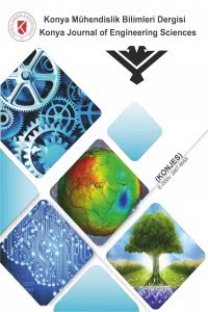Sıvılaşmaya karşı güvenlik katsayısının yapay sinir ağları ile tahmin edilmesi:Denizli-Gümüşler örneği
Estimation of liquefaction resistance by artifical neural network:A case study for Denizli-Gümüşler
___
Baziar, M. H. and Ghorbani, A., 2005, Evaluation of Lateral Spreading Using Artificial Neural Networks, Soil Dynamics and Earthquake Engineering 25, pp. 1-9.Bodri, L. and Cermak, V., 2000, Prediction of Extreme Precipitation Using a Neural Network: Application.to Summer Flood in Moravia, Advances in Engineering, 31, pp. 311-321.
Casagrande, A. 1975, Liquefaction and Cyclic Deformation of Sands: A Critical Review, Proceedings of the 5th Pan-American Conference on Soil Mechanics and Foundation Engineering, Vol. 5, Buenos Aires, Argentina, pp. 79-133.
Dibike, Y. B. and Solomatine, D. P., 2001, River Flow Forecasting Using Artificial Neural Networks, Physics and Chemistry of the Earth, Part B: Hydrology, Oceans and Atmosphere, 26, No.l, pp. 1-7.
Fırat, M., 2002, Doğrusal ve Kıvrımlı Akarsulara Yerleştirilen Köprü Ayakları Etrafında Meydana Gelen Oyulma Derinliğinin Yapay Sinir Ağları ile Belirlenmesi, Yüksek Lisans Tezi, Pamukkale Üniversitesi, 133 s.
Fırat, M. and Güngör, M., 2004, Askı Maddesi Konsantrasyonu ve Miktarının Yapay Sinir Ağları ile Belirlenmesi. İMO Teknik Dergi, Cilt 15 (3), 3267-3282.
Hanna, A. M., Ural, D., and Saygili, G., 2007, Neural Network Model for Liquefaction Potential in Soil Deposits Using Turkey and Taiwan Earthquake Data, Soil Dynamics and Earthquake Engineering 27, pp. 521-540.
Hjelmfelt, A. T. and Wang, M., 1996, Predicting Runoff Using Artificial Neural Networks, Surface Water Hydrology, pp. 233-244.
Hsu, K., Gupta, H. V. and Sorooshian, S., 1998, Streamflow Forecasting Using Artificial Neural Networks, ASCE Water Resources Engineering Conference 98, pp. 967-972.
Ishihara, K. 1985, Stabilitiy of Natural Deposits During Earthquakes, Proceedings of the Eleventh International Conference on Soil Mechanics and Foundation Engineering, vol., 1, San Francisco, pp. 321-376.
Iwasaki, T., Tatsuoka, F., Tokida, K. I., and Yasuda, S., 1978, A Practical Method for Assessing Soil Liquefaction Potential Based on Case Studies at Various Sites in Japan, Proceedings 2nd International Conference on Microzonation, San Francisco, pp. 885-896.
Iwasaki, T., Tokida, K. I., Tatsuoka, F., Watanabe, S., Yasuda, S. and Sato, H., 1982, Microzonation for Soil Liquefaction Potential Using Simplified Methods, Proceedings Third International Earthquake Microzonation Conference, Seattle, pp. 1319-1330.
Jang, J. S. R., Sun, C. T. and Mizutani, E., 1997, Neuro-Fuzzy and Soft Computing, Prentice Hall, ISBN 0-13-261066-3, p. 607.
Luk, C. K., Ball, J. E. and Sharma A., 2001, An Application of Artificial Neural Networks for Precipitation Forecasting, Mathematical and Computer Modelling, 33, p. 683-693.
Mogami, T., and Kubu, K., 1953, The Behavior of Soil During Vibration, Proceedings 3rd International Conference on Soil Mechanics and Foundation Engineering, Zurich, Vol. 1, pp. 152-155.
Nasr, G.E., Badr, E.A. and Joun, C., 2003, Back Propagation Neural Networks for Modelling Gasoline Consumption, Energy Conversion and Management, 44, pp. 893-905.
Seed, H. B., 1970, Soil Problems and Soil Behaviour, Chapter 10 of Earthquake Engineering, Robert L. Wiegel, coordinating ed. Prentice Hall, Englewood Cliffs, NJ, pp. 227-251.
Sönmez, H., 2003, Modification of the Liquefaction Potential Index and Liquefaction Susceptibility Mapping for a Liquefaction-Prone Area (Inegol, Turkey), Environmental Geology, 44, pp. 862-871.
Sönmez, H. ve Gökçeoğlu, C., 2005, A Liquefaction Severity Index Suggested for Engineering Practice, Environmental Geology, 48, pp. 81-91.
Şen, G., 2004, Gümüşler Belediyesi Mücavir Alanının Sıvılaşma Analizi ve Coğrafi Bilgi Sisteminde Uygulaması, Yüksek Lisans Tezi, Pamukkale Üniversitesi, 99 s.
Toprak, S. and Holzer, T. L., 2003, Liquefaction Potential Index: Field Assessment, ASCE Journal of Geotechnical and Geoenvironmental Engineering, 129, pp. 315-322.
Wang, J., 1999, Artificial Neural Network and Fuzzy Neural Integrated Systems for Geotechnical Modeling, PhD Thesis, Graduate Faculty of North Carolina State University, p. 280.
Wang, J. and Rahman, M. S., 1999, A Neural Network Model for Liquefaction-induced Horizontal Ground Displacement, Soil Dynamics and Earthquake Engineering, 18, pp. 555-568.
Young-Su, K. and Byung-Tak, K., 2006, Use of Artificial Neural Networks in the Prediction of Liquefaction Resistance of Sands, Journal of Geotechnical and Geoenvironmental Engineering, ASCE, Vol. 132, No. 11, pp. 1502-1504.
Youd, T.L., Idriss, I.M., Andrus, R.D., Arango, I., Castro, G., Christian, J. T., Dobry, R., Liam Finn, W.D., Harder Jr., L.F., Hynes, M.E., Ishihara, K., Koester, J.P., Liao, S.S.C., Marcuson III, W. F., Martin, G. R., Mitchell, J. K., Moriwaki, Y., Power, M. S., Robertson, P. K., Seed, R. B. and Stokoe II, K. H., 2001, Liquefaction Resistance of Soils: Summary Report from the 1996 NCEER and 1998 NCEER/NSF Workshops on Evaluation of Liquefaction Resistance of Soils, ASCE, Journal of Geotechnical and Geoenvironmental Engineering, 127, pp. 817-833.
Zhang, B. and Govindaraju, R. S., 1998, Using Modular Neural Networks to Predict Watershed Runoff, ASCE Water Resources Engineering Conference 98, pp. 897-902.
- ISSN: 1300-5200
- Yayın Aralığı: Yılda 4 Sayı
- Başlangıç: 2018
- Yayıncı: -
Rize ilindeki sıcak ve mineralli suların hidrokimyasal özellikleri
Güler GÖÇMEZ, İsmail KARA, Ayaz Ayla BOZDAĞ
Maden işletmelerinde jeoloji bilgisinin mühendislik problemlerine etkisi
Gulmustafa ŞEN, Erdal AKYOL, Mahmut FIRAT
Gümüşler(Denizli) yerleşim alanının jeolojik-jeoteknik özellikleri
Erdal AKYOL, Ali KAYA, SUAT TAŞDELEN, TURGAY BEYAZ, Gulmustafa ŞEN
Orta Anadolu Bölgesi Aksaray- Güzelyurt kaolinitik killerinin FT-IR spektropisi ile incelenmesi
Burhan DAVARCIOĞLU, Refik KAYALI
Ilgın(Konya)kuzeyinin stratigrafisi ve tektonik evrimi
MEHMET YAVUZ HÜSEYİNCA, Yaşar EREN
Doğu Karadeniz Bölgesi kil mineralleşmelerinin oluşumu ve kökeni
NECATİ KARAKAYA, Muazzez Çelik KARAKAYA, Kevin FAURE
T. ALTAY, M. Ç. KARAKAYA, Y. ERKAN
